Geothermal Play Types along the East Africa Rift System: Examples from Ethiopia, Kenya and Tanzania
Abstract
:1. Introduction
2. Regional Geological Background
3. North-Eastern Branch: Alalobeda
3.1. Geophysical and Geochemical Data
3.2. Conceptual Model
4. South-Eastern Branch: Menengai
4.1. Geophysical and Geochemical Data
4.2. Conceptual Model
5. Western Branch: Kilambo-Ilwalilo
5.1. Geophysical and Geochemical Data
5.2. Conceptual Model
6. Concluding Remarks
Author Contributions
Funding
Data Availability Statement
Conflicts of Interest
References
- Hafner, M.; Tagliapietra, S.; Falchetta, G.; Occhiali, G. Renewables for Energy Access and Sustainable Development in East Africa; SpringerBriefs in Energy; Springer: Cham, Switzerland, 2019. [Google Scholar] [CrossRef]
- Bouhal, T.; Agrouaz, Y.; Kousksou, T.; Allouhi, A.; El Rhafiki, T.; Jamil, A.; Bakkas, M. Technical feasibility of a sustainable Concentrated Solar Power in Morocco through an energy analysis. Renew. Sustain. Energy Rev. 2018, 81, 1087–1095. [Google Scholar] [CrossRef]
- Adenle, A.A. Assessment of solar energy technologies in Africa-opportunities and challenges in meeting the 2030 agenda and sustainable development goals. Energy Policy 2018, 137, 111180. [Google Scholar] [CrossRef]
- Nicholson, S. Climatic and environmental change in Africa during the last two centuries. Clim. Res. 2001, 17, 123–144. [Google Scholar] [CrossRef]
- Hochstein, M.P. Geothermal systems along the East-African Rift. Bulletin d’Hydrogéologie 1999, 17, 301–310. [Google Scholar]
- Elbarbary, S.; Abdel Zaher, M.; Saibi, H.; Fowler, A.R.; Saibi, K. Geothermal renewable energy prospects of the African continent using GIS. Geotherm. Energy 2022, 10, 8. [Google Scholar] [CrossRef]
- Shi, Y.; Rop, E.; Wang, Z.; Jiang, G.; Wang, S.; Hu, S. Characteristics and formation mechanism of the Olkaria geothermal system, Kenya revealed by well temperature data. Geothermics 2021, 97, 102243. [Google Scholar] [CrossRef]
- Pasqua, C. Advances in the Exploration of Geothermal Resources of the East Africa Rift System (EARS). Ph.D. Thesis, University of Genoa, Genoa, Italy, 2019; 136p. [Google Scholar]
- Moeck, I.S. Catalog of geothermal play types based on geologic controls. Renew. Sustain. Energy Rev. 2014, 37, 867–882. [Google Scholar] [CrossRef]
- Abebe, G.H.; Hersir, G.P.; Benediktsdóttir, A.; Geirsson, H. Multi-Dimensional Inversion of Electromagnetic Data from Alalobeda, Tendaho Geothermal Field in NE-Ethiopia and its Geothermal Significance. In Proceedings of the World Geothermal Congress 2020+1, Reykjavik, Iceland, 24–27 October 2021. [Google Scholar]
- Omenda, P.A. The geology and geothermal activity of the East African Rift. In Proceedings of the Short Course VII on Exploration for Geothermal Resources, Organized by UNU-GTP, GDC and KenGen, Naivasha, Kenya, 31 October–23 November 2013. [Google Scholar]
- Smith, M. Stratigraphic and structural constraints on mechanisms of active rifting in the Gregory Rift, Kenya. Tectonophysics 1994, 236, 3–22. [Google Scholar] [CrossRef]
- Craig, T.J.; Jackson, J.A.; Priestley, K.; McKenzie, D. Earthquake distribution patterns in Africa: Their relationship to variations in lithospheric and geological structure, and their rheological implications. Geophys. J. Int. 2011, 185, 403–434. [Google Scholar] [CrossRef]
- Stamps, D.S.; Calais, E.; Saria, E.; Hartnady, C.; Nocquet, J.M.; Ebinger, C.J.; Fernandes, R.M. A kinematic model for the East African Rift. Geophys. Res. Lett. 2008, 35, 1–6. [Google Scholar] [CrossRef]
- Chorowicz, J. The East African rift system. J. Afr. Earth Sci. 2005, 43, 379–410. [Google Scholar] [CrossRef]
- Last, R.J.; Nyblade, A.A.; Langston, C.A. Crustal structure of the East African Plateau from receiver functions and Rayleigh wave phase velocities. J. Geophys. Res. 1997, 102, 24469–24483. [Google Scholar] [CrossRef]
- Dugda, M.T.; Nyblade, A.A.; Julia, J.; Langston, C.A.; Ammon, C.J.; Simiyu, S. Crustal structure in Ethiopia and Kenya from receiver function analysis: Implications for rift development in eastern Africa. J. Geophys. Res. 2005, 110, 1–15. [Google Scholar] [CrossRef]
- Cornwell, D.G.; Maguire, P.K.H.; England, R.W.; Stuart, G.W. Imaging detailed crustal structure and magmatic intrusion across the Ethiopian Rift using a dense linear broadband array. Geochem. Geophys. Geosyst. 2010, 11, 1–21. [Google Scholar] [CrossRef]
- Prodehl, C.; Jacobs, A.W.B.; Thybo, E.; Dindi, E.; Stangl, R. Crustal structure on the northeastern flank of the Kenya rift. Tectonophysics 1994, 236, 271–290. [Google Scholar] [CrossRef]
- Prodehl, C.; Ritter, J.R.R.; Mechie, J.; Keller, G.R.; Khan, M.A.; Jacob, B.; Fuchs, K.; Nyambok, I.; Obel, J.; Riaroh, D. The KRISP 94 lithospheric investigation of southern Kenya: The experiments and the main results. Tectonophysics 1997, 278, 121–147. [Google Scholar] [CrossRef]
- Camelbeeck, T.; Iranga, M.D. Deep crustal earthquakes and active faults along the Rukwa trough, eastern Africa. Geophys. J. Int. 1996, 124, 612–630. [Google Scholar] [CrossRef]
- Mohr, P.A. Nature of the crust beneath magmatically active continental rifts. Tectonophysics 1992, 213, 269–284. [Google Scholar] [CrossRef]
- Keller, G.R.; Prodehl, C.; Mechie, J.; Fuchs, K.; Khan, M.A.; Maguire, P.; Mooney, W.; Achauer, U.; Davis, P.; Meyer, R.; et al. The East African rift system in the light of KRISP 90. Tectonophysics 1994, 236, 465–483. [Google Scholar] [CrossRef]
- Bosworth, W. Off-axis volcanism in the Gregory rift, east Africa: Implications for models of continental rifting. Geology 1987, 15, 397–400. [Google Scholar] [CrossRef]
- Ebinger, C.J.; Deco, A.L.; Drake, R.E.; Tesha, A.L. Chronology of Volcanism and Rift Basin Propagation: Rungwe Volcanic Province, East Africa. J. Geophys. Res. 1989, 94, 15785–15803. [Google Scholar] [CrossRef]
- Omenda, P.A. The geothermal activity of the East African Rift. In Proceedings of the Short Course IV on Exploration for Geothermal Resources, organized by UNU-GTP, KenGen and GDC, Lake Naivasha, Kenya, 1–22 November 2009. [Google Scholar]
- Abbate, E.; Passerini, P.; Zan, L. Strike-slip Faults in a Rift Area: A Transect in the Afar Triangle, East Africa. Tectonophysics 1995, 241, 67–97. [Google Scholar] [CrossRef]
- Acocella, V.; Abebe, B.; Korme, T.; Barberi, F. Structure of Tendaho Graben and Manda Hararo Rift: Implications for the Evolution of the Southern Red Sea Propagator in Central Afar. Tectonics 2008, 27, TC4016. [Google Scholar] [CrossRef]
- Battistelli, A.; Yiheyis, A.; Calore, C.; Ferragina, C.; Abatneh, W. Reservoir engineering assessment of Dubti geothermal field, Northern Tendaho Rift, Ethiopia. Geothermics 2002, 31, 381–406. [Google Scholar] [CrossRef]
- Rizzello, D.; Armadillo, E.; Pasqua, C.; Verdoya, M.; Kebede, S.; Mengiste, A.; Giorgis, G.H. Three-dimensional geophysical modelling of the Alalobeda geothermal field. In Proceedings of the 6th African Rift Geothermal Conference, Addis Ababa, Ethiopia, 2–4 November 2016. [Google Scholar]
- Maggi, A.; Jackson, J.A.; McKenzie, D.; Priestley, K. Earthquake focal depths, effective elastic thickness, and the strength of the continental lithosphere. Geology 2000, 28, 495–498. [Google Scholar] [CrossRef]
- Pasquale, V.; Chiozzi, P.; Verdoya, M. Tectonothermal processes and mechanical strength in a recent orogenic belt: Northern Apennines. J. Geophys. Res. 2010, 115, 1–17. [Google Scholar] [CrossRef]
- Didana, Y.L.; Thiel, S.; Heinson, G. Three-dimensional conductivity model of the Tendaho High Enthalpy Geothermal Field, NE Ethiopia. J. Volcanol. Geotherm. Res. 2015, 290, 53–62. [Google Scholar] [CrossRef]
- Pasqua, C.; Armadillo, E.; Rizzello, D.; Verdoya, M.; Chiozzi, P.; Kebede, S. Integrated analysis of geochemical and geophysical data from Alalobeda geothermal field Northern Afar region. In Proceedings of the 6th African Rift Geothermal Conference, Addis Ababa, Ethiopia, 2–4 November 2016. [Google Scholar]
- Giggenbach, W.F. Geothermal solute equilibria. Derivation of Na-K-Mg-Ca geoindicators. Geochim. Cosmochim. Acta 1988, 52, 2749–2765. [Google Scholar] [CrossRef]
- Waichel, B.L.; de Lima, E.F.; Sommer, C.A.; Lubachesky, R. Peperite formed by lava flows over sediments: An example from the central Paraná Continental Flood Basalts, Brazil. J. Volcanol. Geotherm. Res. 2007, 159, 343–354. [Google Scholar] [CrossRef]
- Pellerin, L.; Johnston, J.M.; Hohmann, G.W. A numerical evaluation of electromagnetic methods in geothermal exploration. Geophysics 1996, 61, 121–130. [Google Scholar] [CrossRef]
- Ussher, G.; Harvey, C.; Johnstone, R.; Anderson, E. Understanding the resistivities observed in geothermal systems. In Proceedings of the World Geothermal Congress 2000, Kyushu-Tohoku, Japan, 28 May–10 June 2000. [Google Scholar]
- Anderson, E.; Crosby, D.; Ussher, G. Bull’s eye!—Simple resistivity imaging to reliably locate the geothermal reservoir. In Proceedings of the World Geothermal Congress, Kyushu-Tohoku, Japan, 28 May–10 June 2000; pp. 909–914. [Google Scholar]
- Stimac, J.; Armadillo, E.; Kebede, S.; Zemedkun, M.; Kebede, Y.; Teclu, A.; Rizzello, D.; Mandeno, P.E. Integration and Modeling of Geoscience Data from the Tendaho Geothermal Area, Afar Rift, Ethiopia. In Proceedings of the 5th African Rift geothermal Conference, Arusha, Tanzania, 29–31 October 2014. [Google Scholar]
- Tessema, A.; Antoine, L.A.G. Processing and interpretation of the gravity field of the East African Rift: Implication for crustal extension. Tectonophysics 2004, 394, 87–110. [Google Scholar] [CrossRef]
- Leat, P.T. Geological evolution of the trachytic caldera volcano Menengai, Kenya rift valley. J. Geol. Soc. 1984, 141, 1057–1069. [Google Scholar] [CrossRef]
- Mungania, J. Overview of the Geology of Menengai Volcanic Complex; Internal Report; Kenya Electricity Generating Company: Nairobi, Kenya, 1999. [Google Scholar]
- Mibei, G.; Lagat, J. Structural controls in Menengai geothermal field. In Proceedings of the Kenya Geothermal Conference, Nairobi, Kenya, 21–23 November 2011. [Google Scholar]
- Omondi, C. Borehole Geology and Hydrothermal Mineralization of Wells MW-01 and MW-02, Menengai Geothermal Field, Central Kenya Rift Valley; Report, Number 30; United Nation University, Geothermal Training Program: Reykjavik, Iceland, 2011. [Google Scholar]
- Lagat, J. Geothermal surface exploration approach: Case study of Menengai geothermal field, Kenya. In Proceedings of the Kenya Geothermal Conference, Nairobi, Kenya, 21–23 November 2011. [Google Scholar]
- Kanda, I.; Fujimitsu, Y.; Nishijima, J. Geological structures controlling the placement and geometry of heat sources within the Menengai geothermal field, Kenya as evidenced by gravity study. Geothermics 2019, 79, 67–81. [Google Scholar] [CrossRef]
- Wheildon, J.; Morgan, P.; Williamson, K.H.; Evans, T.R.; Swanberg, C.A. Heat flow in the Kenya rift zone. Tectonophysics 1994, 236, 131–149. [Google Scholar] [CrossRef]
- Wamalwa, A.M.; Mickus, K.L.; Serpa, L.F. Geophysical characterization of the Menengai volcano, Central Kenya Rift from the analysis of magnetotelluric and gravity data. Geophysics 2013, 78, B187–B199. [Google Scholar] [CrossRef]
- Montegrossi, G.; Pasqua, C.; Battistelli, A.; Mwawongo, G.; Ofwona, C. 3D Natural State Model of the Menengai Geothermal System, Kenya. In Proceedings of the World Geothermal Congress 2015, Melbourne, Australia, 19–25 April 2015. [Google Scholar]
- Henry, W.J.; Mechie, J.; Maguire, P.K.H.; Khan, M.A.; Prodehl, C.; Keller, G.R.; Patel, J. A seismic investigation of the Kenya Rift Valley. Geophys. J. Int. 1990, 100, 107–130. [Google Scholar] [CrossRef]
- Simiyu, S.M.; Keller, G.R. An integrated geophysical analysis of the upper crust of the southern Kenya rift. Geophys. J. Int. 2001, 147, 543–561. [Google Scholar] [CrossRef]
- Simiyu, S.M. Application of micro-seismic method to geothermal exploration from the Kenya Rift. In Proceedings of the Short Course VIII on Exploration for Geothermal Resources, Lake Naivasha, Kenya, 31 October–23 November 2009. [Google Scholar]
- Ebinger, C.J.; Deino, A.L.; Tesha, A.L.; Becker, T.; Ring, U. Tectonic Controls on Rift Basin Morphology: Evolution of the Northern Malawi (Nyasa) Rift. J. Geophys. Res. 1993, 98, 17821–17836. [Google Scholar] [CrossRef]
- Mnjokava, T.; Kimani, A.; Pasqua, C.; Lelli, M.; Marini, L. Geochemistry of Kilambo-Kajala and Ilwalilo Hot Springs, Kiejo-Mbaka Geothermal Prospect, Tanzania. In Proceedings of the 7th African Rift Geothermal Conference, Kigali, Rwanda, 31 October–2 November 2018. [Google Scholar]
- Rizzello, D.; Armadillo, E.; Pasqua, C.; Pisani, P.; Mnjokava, T.; Mwano, J.; Makoye, D.; Tumbu, L. Three-dimensional geophysical modelling of Kiejo-Mbaka geothermal field, Tanzania. In Proceedings of the 7th African Rift Geothermal Conference, Kigali, Rwanda, 31 October–2 November 2018. [Google Scholar]
- Ebinger, C.J.; Rosendahl, B.R.; Reynolds, D.J. Tectonic model of the Malawi rift, Africa. Tectonophysics 1987, 141, 215–235. [Google Scholar] [CrossRef]
- Von Herzen, R.P.; Vacquier, V. Terrestrial heat flow in Lake Malawi, Africa. J. Geophys. Res. 1967, 72, 4221–4226. [Google Scholar] [CrossRef]
- Didas, M.M.; Armadillo, E.; Hersir, G.P.; Cumming, W.; Rizzello, D. Regional thermal anomalies derived from magnetic spectral analysis and 3D gravity inversion: Implications for potential geothermal sites in Tanzania. Geothermics 2022, 103, 102431. [Google Scholar] [CrossRef]
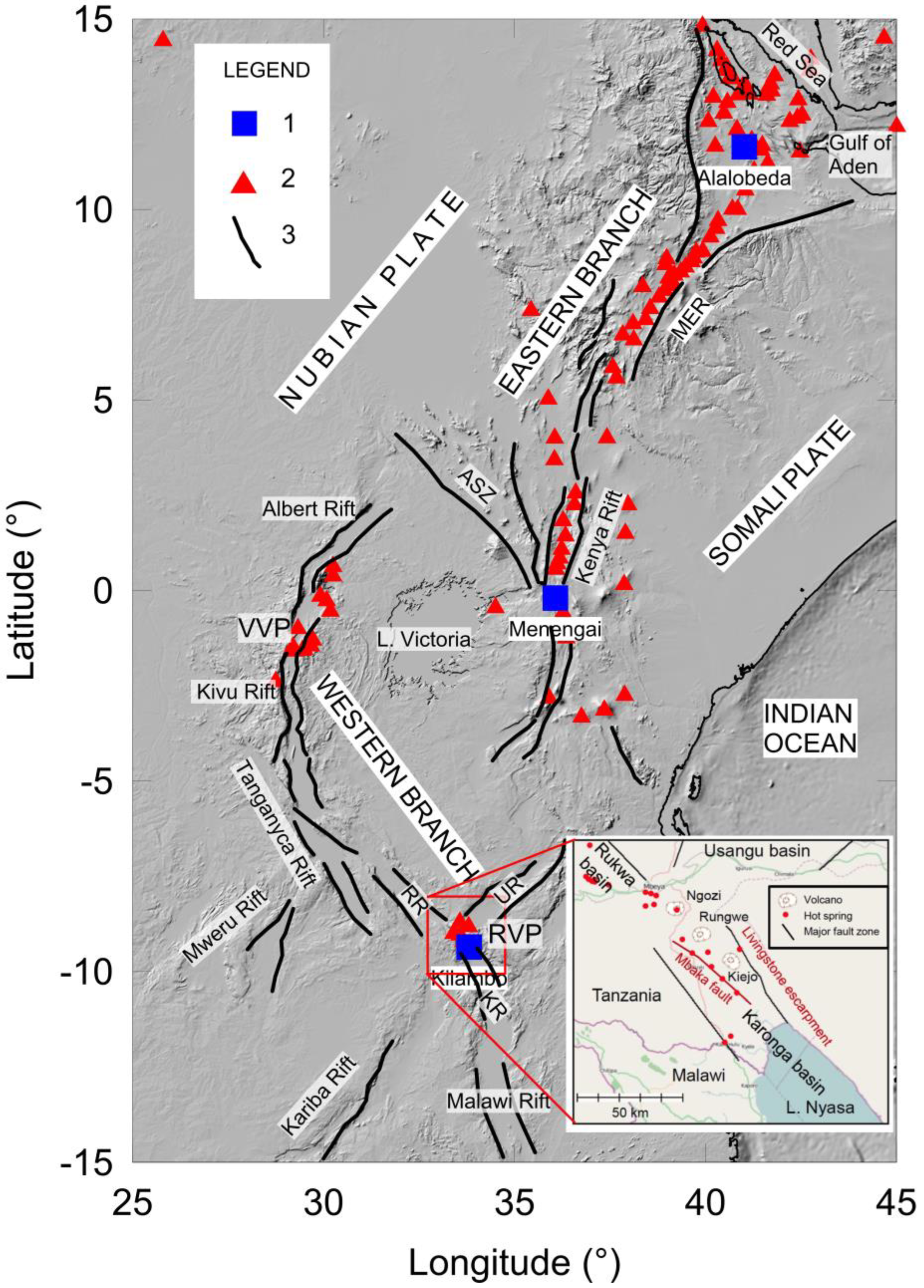

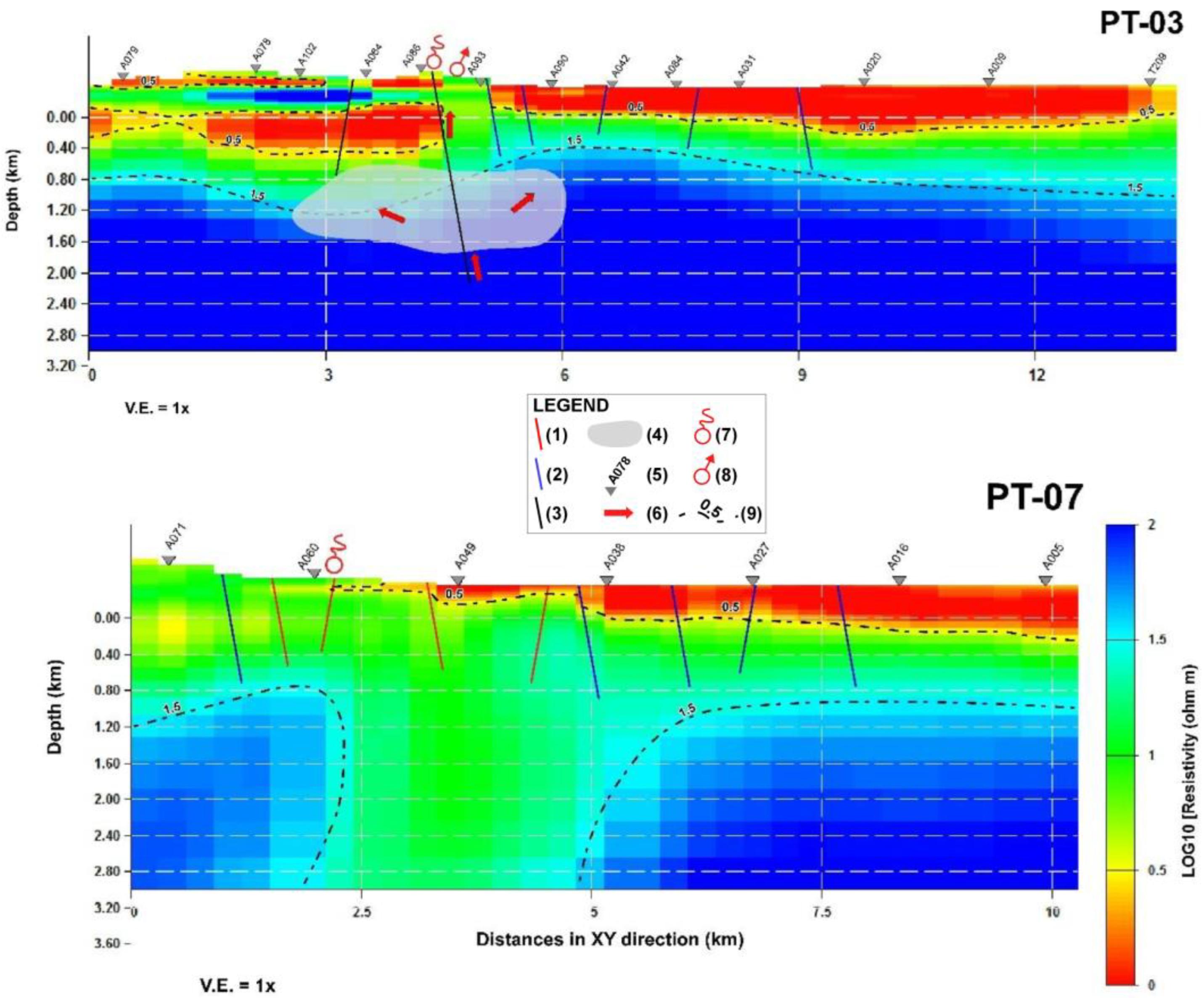
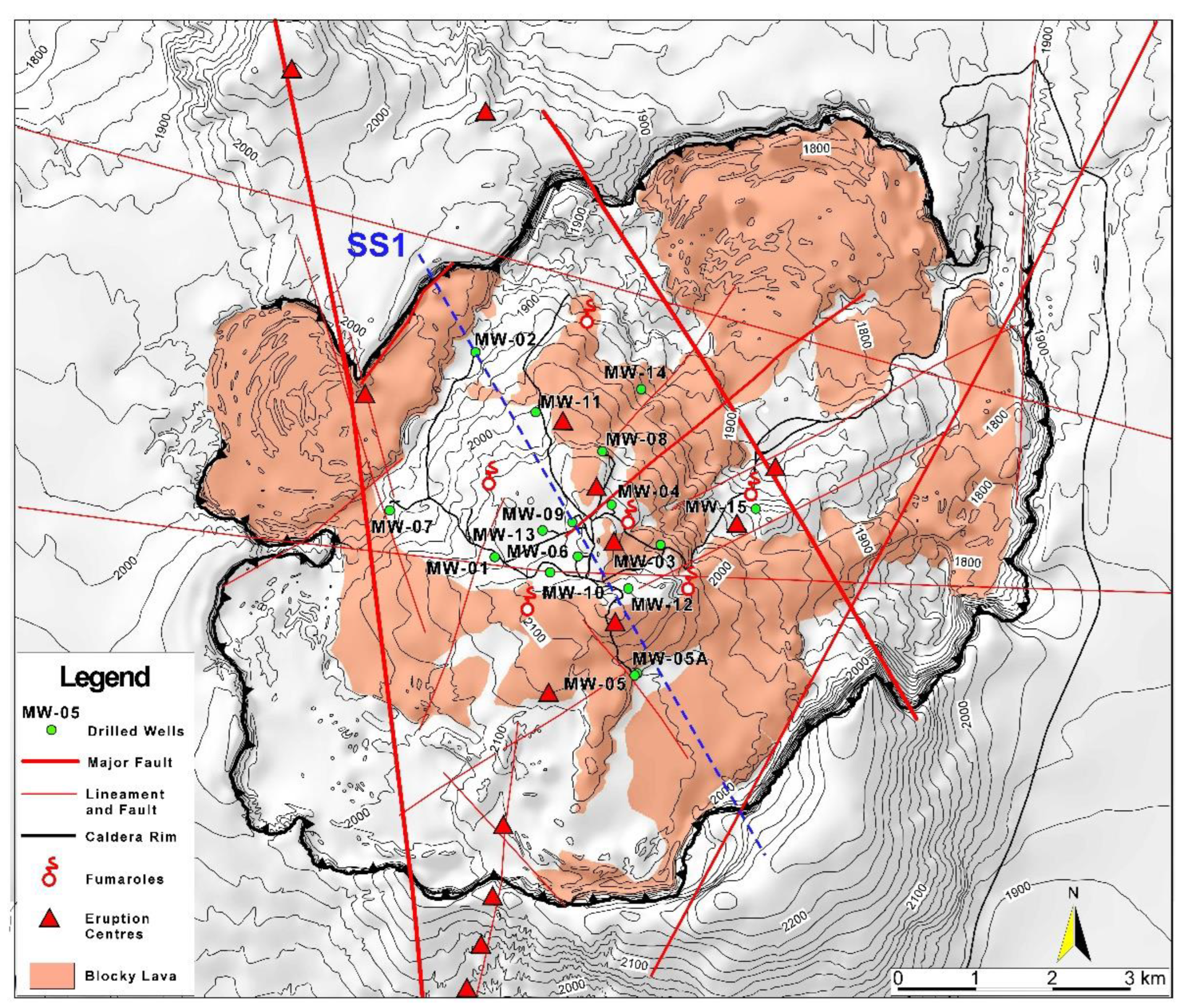
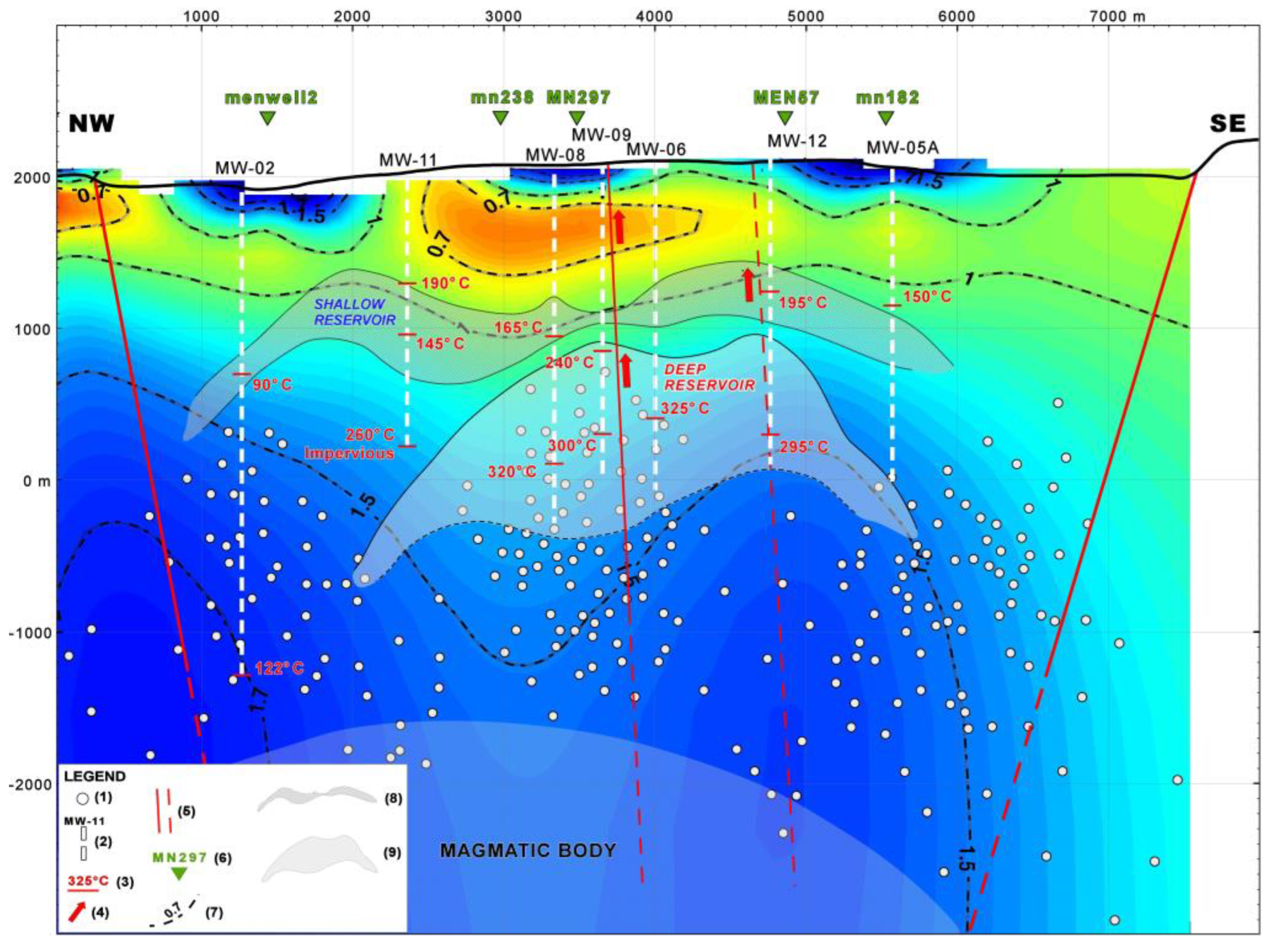

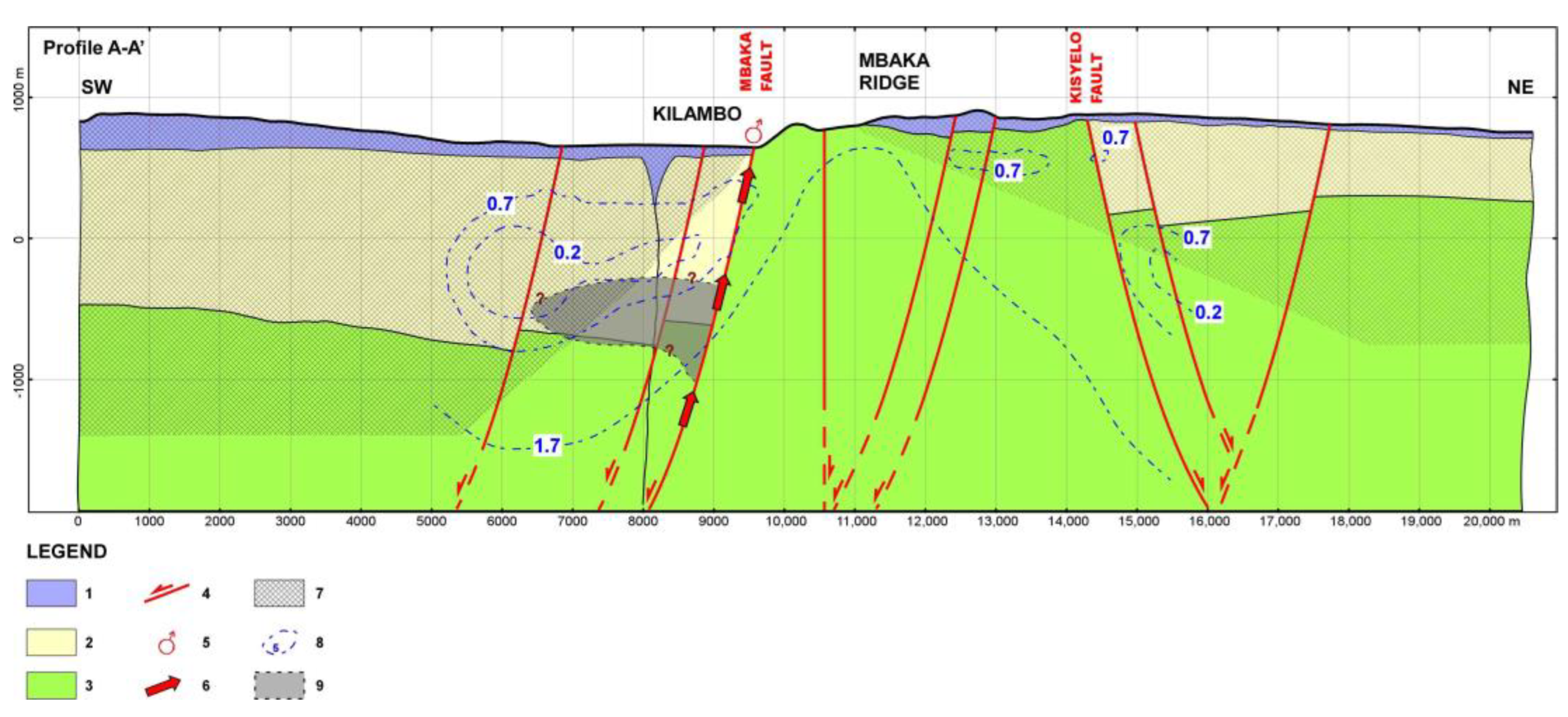
Disclaimer/Publisher’s Note: The statements, opinions and data contained in all publications are solely those of the individual author(s) and contributor(s) and not of MDPI and/or the editor(s). MDPI and/or the editor(s) disclaim responsibility for any injury to people or property resulting from any ideas, methods, instructions or products referred to in the content. |
© 2023 by the authors. Licensee MDPI, Basel, Switzerland. This article is an open access article distributed under the terms and conditions of the Creative Commons Attribution (CC BY) license (https://creativecommons.org/licenses/by/4.0/).
Share and Cite
Pasqua, C.; Chiozzi, P.; Verdoya, M. Geothermal Play Types along the East Africa Rift System: Examples from Ethiopia, Kenya and Tanzania. Energies 2023, 16, 1656. https://doi.org/10.3390/en16041656
Pasqua C, Chiozzi P, Verdoya M. Geothermal Play Types along the East Africa Rift System: Examples from Ethiopia, Kenya and Tanzania. Energies. 2023; 16(4):1656. https://doi.org/10.3390/en16041656
Chicago/Turabian StylePasqua, Claudio, Paolo Chiozzi, and Massimo Verdoya. 2023. "Geothermal Play Types along the East Africa Rift System: Examples from Ethiopia, Kenya and Tanzania" Energies 16, no. 4: 1656. https://doi.org/10.3390/en16041656




